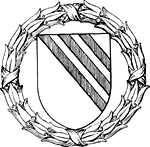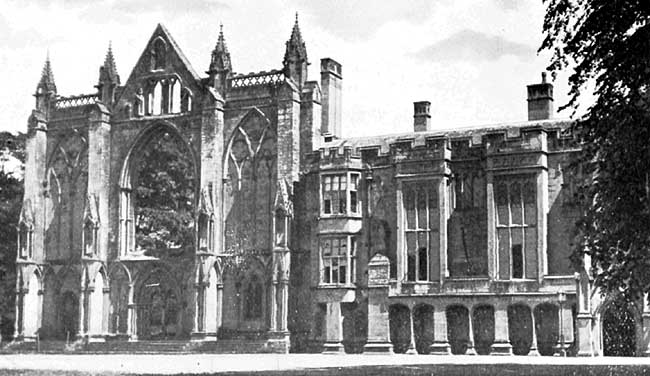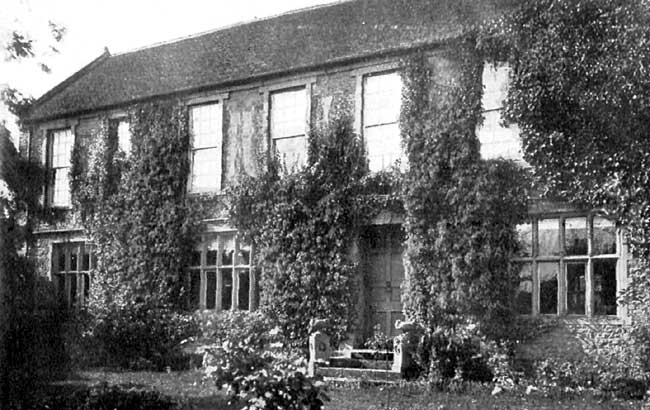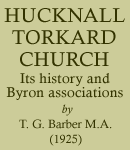BYRON ASSOCIATIONS.

The Byron Arms.
THE association of the Byron family with Hucknall Torkard dates back to the 11th Century. Two members of the family came over with William the Conqueror, and settled in England.
Of Erneis de Buron, who held lands in York and Lincoln we hear little.
Ralph de Buron, the ancestor of the Poet, is mentioned in Domesday Book (1086) as a landowner in Hochenale (Hucknall Torkard). The entry is as follows:--
"Ralph de Burun's Land (Manor). — In Hochenale Ulchet had 12 bovates of land to the geld. Land for 2 ploughs. There Osmund, Ralph's man, has one plough, and 5 villeins have 3½ ploughs. Wood for pannage (pig's food), one league in length, and half a league in breadth. In King Edward's time it was worth 30 shillings. Now it is worth 15 shillings.
A number of illustrious names stand out in the history of the race during the next four centuries.
Hugh Byron, the Lord of Horestan Castle in Derbyshire,
Robert de Byron, who lived in the reign of Henry II., and who, by his marriage with Cecilia, heiress of Sir Richard Clayton, added to the family possessions an estate in Lancashire.
Sir John Byron, who served with distinction in the wars of Edward I., and was made Governor of the City of York.
Another Sir John Byron, four generations later was knighted by Richmond, afterwards Henry VII., on his landing at Milford.
Nicholas Byron, his brother, was knighted in 1502, at the marriage of Prince Arthur.
What association these members of the family had with Hucknall the chronicler does not narrate. Part of the Byron Manor may have remained in their hands during these years. It appears, how-ever, that some of the estate was given to Newstead Priory.
Newstead Priory was one of the three religious houses built by King Henry II. to atone for the murder of Thomas a Becket, Archbishop of Canterbury. It was founded in 1170, and for 370 years was the centre of the religious life of this district. The Prior and his Brothers belonged to the Order of St Augustine.
The association between Newstead Priory and Hucknall Torkard was very intimate. From 1288 until the dissolution of the Monastery in 1539 the Prior and Brothers of Newstead were the Patrons of the Living of Hucknall Torkard.
In 1406 John of Hockendale was Prior of Newstead.
In 1540, the year following the dissolution of the Monastery, the Priory and all its lands (including the greater part of Hucknall Torkard) passed into the possession of Sir John Byron. He was known as "Little Sir John of the great beard," and appears to have been a great favourite of Henry VIII.

Newstead Priory—The Home of the Byron Family. 1540 - 1818 A.D.
It was at this time, we may assume, the association between Hucknall Torkard Church and the Byron family began. Although there is no record substantiating the assumption—no evidence that Sir John ever entered the Church, or conferred any benefaction upon it—yet it is reasonable to suppose that, as Lord of the Manor, he would, upon occasions, worship within its walls, and take a pious interest in the work of the five Priests who held the Cure of Hucknall Torkard between the year 1540 and 1576, the year of his death.
The successor of "little Sir John of the great Beard" was John Byron of Clayton, who inherited by deed of gift. His interest in the Church is evidenced by the fact that he was the founder of the Byron Charity on February 21, 1571, by which the Church and the Poor have, during the last 350 years benefited considerably. Whilst his father was alive, he probably lived at Bulwell Wood Hall, in the parish of Hucknall Torkard. His wife was Alice, daughter of Sir Nicholas Strelley. In 1579 he was knighted by Elizabeth, and went to live at Newstead.

Bulwell Wood Hall - The Home of John Byron of Clayton, and William Byron, the 3rd Lord, before he succeeded the Peerage.
His son, John Byron, was made a Knight ot the Bath at the Coronation of James I., and became Governor of the Tower. It was in the time of this Sir John that the patronage of the Hucknall Torkard Living passed to the Byron family. He died in 1625.
His successor was another Sir John Byron. During his time, Newstead is said to have been besieged and taken by the enemies of the King, but he himself escaped. For his services as a Royalist, especially at the first Battle of Newbury in 1643, he was, on October 24th of the same year, created Baron of Rochdale, and so became the first peer of the family.
In these troublous times the tenor bell was placed in the Tower of Hucknall Torkard Church, bearing the inscription: "God save the Church!" It is more than probable that this bell was the gift of the Lord of the Manor.
In the year 1638 we have the following entry in the Hucknall Register:—
1638.—Cicilie Ladie Byron was buried ye xxii. of February.
Sir Richard Byron, the second brother of the first Lord, was born in 1605. For his conduct at Edgehill Charles I. conferred a knighthood upon him. He is famous in the war for his government and gallant defence of Newark. In 1652 he succeeded to the Peerage. The vault in Hucknall Torkard Church contains the bodies of two of his daughters (Anne and Cicile), a sister (?), and his first and second wife. The entries appear in the Church Register as follows:—
1640.—Anne Biron, daughter of Richard Biron, Esqre. of Newstead, buried the xii. of April.
1641.—Mistress Byron (his supposed sister) was buried the xth day of May.
1641.—Mistress Cicilie Byron, daughter of Richard Byron, Esqre., buried the 5th of May.
His first wife, Lady Elizabeth Byron, died on March 22, 1657. There is no entry of her burial in the register, but she is commemorated on a tablet.
